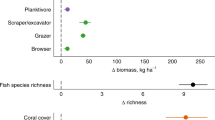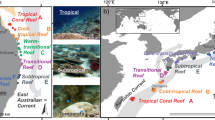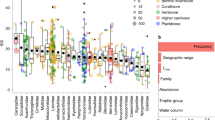Abstract
Habitat reserves can promote ecological resilience to climate variability by supporting intact trophic webs and large-bodied individuals1,2,3. Protection may also alter community responses to long-term climate change by offering habitat for range-shifting species4. Here we analyse the species richness, diversity and functional traits of temperate reef fish communities over 20 years in a global warming hotspot and compare patterns in a marine reserve with nearby sites open to fishing. Species richness and diversity oscillated strongly on the decadal scale. Long-term warming signatures were also present as increasing functional trait richness and functional diversity, driven in part by a general increase in herbivores. Nevertheless, reserve sites were distinguished from fished sites by displaying: greater stability in some aspects of biodiversity; recovery of large-bodied temperate species; resistance to colonization by subtropical vagrants; and less pronounced increases in the community-averaged temperature affinity. We empirically demonstrate that protection from fishing has buffered fluctuations in biodiversity and provided resistance to the initial stages of tropicalization.
This is a preview of subscription content, access via your institution
Access options
Subscribe to this journal
Receive 12 print issues and online access
$209.00 per year
only $17.42 per issue
Buy this article
- Purchase on Springer Link
- Instant access to full article PDF
Prices may be subject to local taxes which are calculated during checkout




Similar content being viewed by others
References
Behrens, M. D. & Lafferty, K. D. Effects of marine reserves and urchin disease on southern California rocky reef communities. Mar. Ecol. Prog. Ser. 279, 129–139 (2004).
Micheli, F. et al. Evidence that marine reserves enhance resilience to climatic impacts. PLoS ONE 7, e40832 (2012).
Mumby, P. J., Wolff, N. H., Bozec, Y-M., Chollett, I. & Halloran, P. Operationalizing the resilience of coral reefs in an era of climate change. Conserv. Lett. http://dx.doi.org/10.1111/conl.12047 (2013).
Thomas, C. D. et al. Protected areas facilitate species’ range expansions. Proc. Natl Acad. Sci. USA 109, 14063–14068 (2012).
Bernhardt, J. R. & Leslie, H. M. Resilience to climate change in coastal marine ecosystems. Annu. Rev. Mar. Sci. 5, 371–392 (2013).
Villamor, A. & Becerro, M. A. Species, trophic, and functional diversity in marine protected and non-protected areas. J. Sea Res. 73, 109–116 (2012).
Poloczanska, E. S. et al. Global imprint of climate change on marine life. Nature Clim. Change 3, 919–925 (2013).
Parmesan, C. & Yohe, G. A globally coherent fingerprint of climate change impacts across natural systems. Nature 421, 37–42 (2003).
Sunday, J. M., Bates, A. E. & Dulvy, N. K. Thermal tolerance and the global redistribution of animals. Nature Clim. Change 2, 686–690 (2012).
Cheung, W. W. L., Watson, R. & Pauly, D. Signature of ocean warming in global fisheries catch. Nature 497, 365–368 (2013).
Barrett, N. S., Edgar, G. J., Buxton, C. D. & Haddon, M. Changes in fish assemblages following 10 years of protection in Tasmanian marine protected areas. J. Exp. Mar. Biol. Ecol. 345, 141–157 (2007).
Johnson, C. R. et al. Climate change cascades: Shifts in oceanography, species’ ranges and subtidal marine community dynamics in eastern Tasmania. J. Exp. Mar. Biol. Ecol. 400, 17–32 (2011).
Halpern, B. S. & Floeter, S. R. Functional diversity responses to changing species richness in reef fish communities. Mar. Ecol. Prog. Ser. 364, 147–156 (2008).
Stuart-Smith, R. D. et al. Integrating abundance and functional traits reveals new global hotspots of fish diversity. Nature 501, 539–542 (2013).
Halpern, B. S. The impact of marine reserves: do reserves work and does reserve size matter? Ecol. Appl. 13, 117–137 (2003).
Lester, S. E. L. et al. Biological effects within no-take marine reserves: A global synthesis. Mar. Ecol. Prog. Ser. 384, 33–46 (2009).
Yachi, S. & Loreau, M. Biodiversity and ecosystem productivity in a fluctuating environment: The insurance hypothesis. Proc. Natl Acad. Sci. USA 96, 1463–1468 (1999).
MacArthur, R. Fluctuations of animal populations and a measure of community stability. Ecology 36, 533–536 (1955).
Babcock, R. C. et al. Decadal trends in marine reserves reveal differential rates of change in direct and indirect effects. Proc. Natl Acad. Sci. USA 107, 18256–18261 (2010).
Edgar, G. J., Barrett, N. S. & Stuart-Smith, R. D. Exploited reefs protected from fishing transform over decades into conservation features otherwise absent from seascapes. Ecol. Appl. 19, 1967–1974 (2009).
Floeter, S. R., Behrens, M. D., Ferreira, M. J., Paddack, C. E. L. & Horn, M. H. Geographical gradients of marine herbivorous fishes: Patterns and processes. Mar. Biol. 147, 1435–1447 (2005).
Sala, E., Kizilkaya, Z., Yildirim, D. & Ballesteros, E. Alien marine fishes deplete algal biomass in the eastern Mediterranean. PLoS ONE 6, e17356 (2011).
Sax, D. F. et al. Ecological and evolutionary insights from species invasions. Trends Ecol. Evol. 22, 465–471 (2007).
Edgar, G. J. & Stuart-Smith, R. D. Ecological effects of marine protected areas on rocky reef communities: A continental-scale analysis. Mar. Ecol. Prog. Ser. 388, 51–62 (2009).
Wanger, T. C. et al. Endemic predators, invasive prey and native diversity. Proc. Biol. Sci. 278, 690–694 (2011).
Ling, S. D. & Johnson, C. R. Marine reserves reduce risk of climate-driven phase shift by reinstating size- and habitat-specific trophic interactions. Ecol. Appl. 22, 1232–1245 (2012).
Simberloff, D. & Von Holle, B. Positive interactions of nonindigenous species: Invasional meltdown? Biol. Inv. 1, 21–32 (1999).
FishBase; http://www.fishbase.org
Botta-Dukát, Z. Rao’s quadratic entropy as a measure of functional diversity based on multiple traits. J. Veg. Sci. 16, 533–540 (2005).
Laliberté, E. & Legendre, P. A distance-based framework for measuring functional diversity from multiple traits. Ecology 91, 299–305 (2010).
Acknowledgements
We are grateful for the contributions of the many field technicians that assisted with diving surveys over the 20-year monitoring period, to A. Schaap and P. Bosworth for initiating the monitoring programme, to C. Buxton for continuing lab support, to J. Lefcheck for discussions on the topic of functional diversity and to J. Hulls for providing a map of the study site. A.E.B. was supported by an Australian Government Fisheries Research and Development Corporation and Department of Climate Change and Energy Efficiency grant. Salary for R.D.S-S. was provided by an Australian Research Council Postdoctoral Fellowship. Biological monitoring was financially supported in parts by the Australian and Tasmanian governments (Australian Research Council; Natural Heritage Trust; National Resource Management; Fisheries Research and Development Corporation; and Department of Primary Industries, Parks, Water and Environment) with considerable logistic support from Tasmanian Parks and Wildlife Service. Temperature, salinity and nutrient data from 2009 to 2012 were sourced from the Integrated Marine Observing System (IMOS)—IMOS is supported by the Australian government. The CSIRO Coastal Monitoring programme provided oceanographic data before 2008.
Author information
Authors and Affiliations
Contributions
A.E.B., N.S.B., G.J.E. and R.D.S-S. conceived the idea for the manuscript. N.S.B., G.J.E. and others collected the fish data. A.E.B. analysed the data and drafted the manuscript with significant input from N.S.B., G.J.E. and R.D.S-S. N.J.H. and P.A.T. assisted with collating and interpreting the oceanographic data. All authors commented on manuscript drafts.
Corresponding author
Ethics declarations
Competing interests
The authors declare no competing financial interests.
Supplementary information
Rights and permissions
About this article
Cite this article
Bates, A., Barrett, N., Stuart-Smith, R. et al. Resilience and signatures of tropicalization in protected reef fish communities. Nature Clim Change 4, 62–67 (2014). https://doi.org/10.1038/nclimate2062
Received:
Accepted:
Published:
Issue Date:
DOI: https://doi.org/10.1038/nclimate2062



